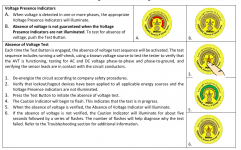I did not know about this device thank you. The part number is VS-AVT-C08-L10 and it currently sells for ~$400 at a local supply house I checked, and is non stock.For new project, I specify the Panduit VeriSafe Absence of Voltage Tester. This is permanently installed and lets you prove absence of voltage without removing a cover. I think once there is a couple of more devices like this are on the market the code will start to require such devices.
probably could get a better deal if added to a job package.
Good info thank you.the requirement is that energized work is only permitted if it's more dangerous to turn the equipment off, which applies to places like hospitals. Troubleshooting is permitted without an EEWP, as is opening up panel covers.
There is copy of 2018 70E I have access to at work, I have just never personally read it yet or had any recent training on it that I was awake for.
I made a copy of that form yesterday.
Just leads to more questions...
For the Troubleshooting that's permitted what PPE do you use for voltages over 300V in the example scenarios above?
What about DC? Say 440 -500V solar PV strings coming into a PV inverter, and the service electrician is removing the cover of the inverter to check string voltage? Probably not much AF current in the DC but still over 300V.
Thanks

